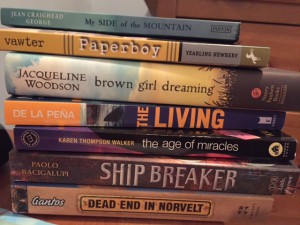It’s almost time for the ninth annual Farm to Table Conference here in Pittsburgh! This is one of my favorite events in the city because I get to meet new people and try new food! I’m really thrilled to participate this year for several reasons. As usual, I’ll be hosting a table and selling copies of My Food Notebook, but I’m also going to unveil a new game for kids called “TASTE or TEST.” When kids visit my table they can choose to TASTE a Mystery Food or take a TEST and answer a really tough (wink, wink) question about Pennsylvania farms and agriculture. If kids are really brave, they can tackle both challenges! When a child does a TASTE or TEST, they will earn an entry into a raffle drawing for a basket of fun, healthy prizes.
I’m also going to bring this fun TASTE or TEST game into the first grades at my local elementary schools to coincide with the Farm to Table unit in the curriculum. As I work on different projects and books for children, I find that taking a look at the standards really helps. I use the PA Standards Aligned System site to see what teachers need to cover in the classroom. Then I try to make sure that the information in my games, activities and books matches the needs of the teacher.
Just because information is required doesn’t mean it can’t be fun! I know kids love learning about healthy foods because I worked with the folks from Farm to Table to create the Super Fun! Local Food Challenge assembly and have performed it in front of screaming crowds of school agers.
I think the TASTE or TEST game is going to be a hit for parents and kids, because trying a new food is a tough challenge for many people.
Trying New Foods
When’s the last time you ate a new food? And I don’t mean trying a new flavor of Triskets. I mean a new fruit or vegetable, maybe a new kind of cheese, or even a new kind of grain.
We get into habits (or ruts) where we eat the same things every day. I know personally it’s easier for me to cook familiar foods. I know how to cook them and (usually) don’t ruin or burn them. But it’s important for parents to model trying a new food if they want their kids to try a new food.
Here’s a challenge. Try to eat one new food every day. Could you do that two days in a row? Could you do it for a week? I’m thinking the next time I go to the grocery store, I could grab five new kinds of fruits and vegetables and give them a try once a day. Sounds intimidating but also a little exciting!
Parents want their kids to try new foods. I asked friends on Facebook what new foods they wished their kids would try and got a great variety of responses. Here are some of the foods:
- Kiwi
- Spinach
- Peppers (red, yellow, orange, green)
- Tomatoes (twice)
- Rambutan (I don’t even know what this is!)
- Mushrooms (twice)
- Eggplants (twice)
- Mangoes (I’m allergic)
- Lima beans
- Roasted brussel sprouts
- Oranges
- Bananas
- Grapes
That’s a pretty good list of new foods to try! Some of those are delicious. But what the heck is a rambutan? Sounds like a new food I need to try.
Be honest now: Which of those foods have you eaten yourself? Which have your kids eaten? If you’re going to tackle this list of new foods with your family, let me know which ones they taste!
Do you think the TASTE or TEST game would be a hit at your child’s school?
Sign up to receive email updates on working with picky eaters and to learn about fun, upcoming events!









